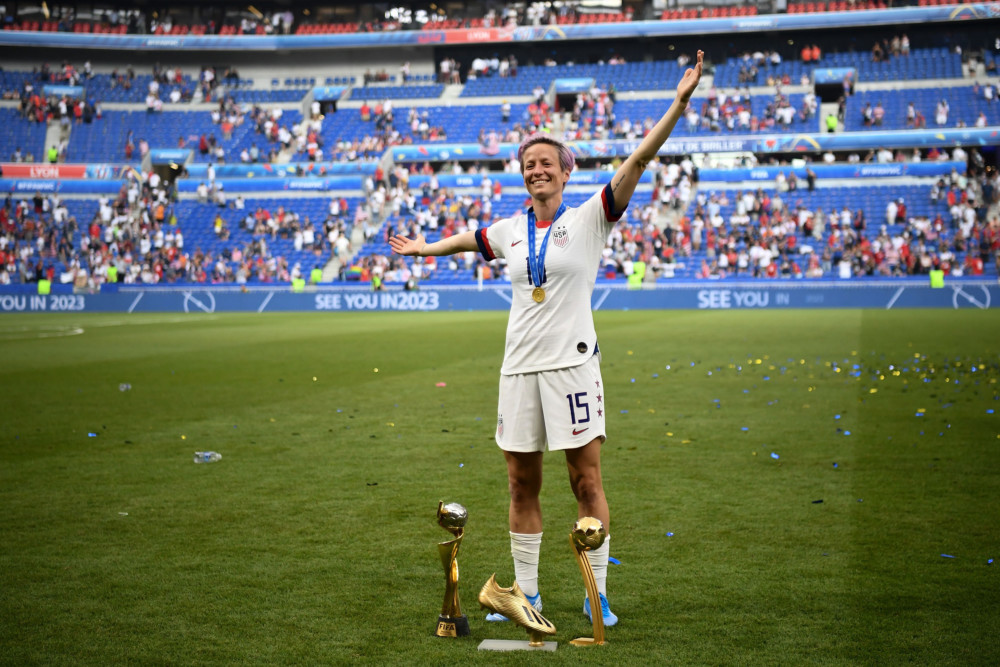By Jonathan Tannenwald
The Philadelphia Inquirer
WWR Article Summary (tl;dr) As Jonathan Tannenwald reports, “This time [the team] not only won every game, they did so on their rivals’ turf in Europe, and with the target of defending champion on their back.”
The Philadelphia Inquirer
To understand just how big a feat the U.S. women’s soccer team achieved in winning the 2019 World Cup, start here: The Americans beat five of the sport’s top 15 teams, including the Nos. 13, 4, 3 and 8-ranked nations in consecutive elimination games.
Four years ago, the Americans only beat four of the top 15, and had the benefit of playing next door to home in Canada. This time they not only won every game, they did so on their rivals’ turf in Europe, and with the target of defending champion on their back.
This team also beat a lot of opponents in its own country. For months leading up to the tournament, players and coaches were peppered with questions about the U.S. falling off its perch as women’s soccer’s preeminent superpower. A lot of fans didn’t think the champs would repeat this summer. Some disagreed with Jill Ellis’ lineups and tactics.
And that’s before President Trump offered his few cents to Megan Rapinoe.
The question that loomed largest wasn’t about Alyssa Naeher’s lack of pedigree or Ellis’ lack of sense. It was whether the U.S. program has developed enough skilled players to keep raising its game as the rest of the world rises faster.
It took a while to learn the answer. The 16 goals scored against Thailand and Chile didn’t mean much given the quality of the opposition. There were moments of brilliance against Sweden, followed by a clash with Spain that felt at times like a hockey game.
Then came the proof. Yes, the U.S. beat France because the hosts cracked under the unrelenting pressure of a World Cup. That been the Americans’ favorite fuel since the pioneers of 1991 won the team’s first title.
But the current champs showed real skill, too. The second goal was terrific, and what should have been a third was even better. It will be lost to history because one of Crystal Dunn’s toes was offside in the buildup.
As for England, be honest, even with hindsight: did they really have the individual quality to match Sam Mewis, Rose Lavelle, Tobin Heath, Rapinoe and so on? No, they didn’t.
Mewis’ success validated those who for months called for her to have a greater role. Opponents had no answer when her 6-foot-1 frame charged through midfield with the ball.
Lavelle was stuck in bad matchups sometimes, but proved on the whole that Jill Ellis was right to put her playmaking talent at center stage. Her goal in the final, a fine shot after a rampaging run up the middle, officially silenced the critics.
Heath wasn’t always great, but was always dangerous enough to not be left alone. That was proven by how many teams focused on snuffing her out.
Most remarkably, the U.S won the World Cup despite Ellis repeatedly leaving Lindsey Horan, the team’s best individual talent, on the bench. Horan played just 357 of 630 possible minutes, was a substitute against France and Spain, and was out of the final completely.
Then there was Rapinoe, taking her place in the lineage of U.S. stars who seize the spotlight. She had as much ice in her veins at the microphone as she did at the penalty spot.
Put it on me, she told the world, because I can take it. And in doing so, she deflected attention from players who didn’t want it.
buy levitra soft generic buy levitra soft online no prescription
Might that include the player who put the U.S. in the final? Alex Morgan is no stranger to the big stage, but after scoring five goals in the opener she scored none in four straight. When Rapinoe commanded the headlines, there was barely a word about the drought.
Yet Morgan worked her rear off all along. She took poundings from opponents, especially Spain. And when it counted most, she rose above England and sent them home with as much force as her tea-dumping ancestors two centuries ago. Her celebration was fully-earned, as was the riposte to men who flaunt their successes but believe female athletes shouldn’t.
Let’s not forget the defense either: Naeher’s big saves, Abby Dahlkemper’s great passes, Becky Sauerbrunn’s leadership, Julie Ertz’s grit, and Crystal Dunn and Kelley O’Hara’s hustle. Remember the complaints about this team not having a true left back?
Dunn still isn’t one, but she was outstanding in France.
Now the story turns to what comes next. There should be a lot, and well after Wednesday’s ticker-tape parade in New York. If four World Cup stars and four Olympic gold medals haven’t proven that, what will?
After setting Nike’s record for the most-sold soccer jersey of any gender in a single season, will the sportswear giant ensure it’s easy to break the record again? Will the U.S. Soccer Federation see to it that pay inequities derived from its own revenues are resolved? Most importantly, will media and corporate sponsors step up to treat the NWSL as a major league, not a sideshow? (And will the league and its U.S. Soccer overlords make sure they can?)
Were these decisions solely up to the millions of American fans who watched the final, we’d know the answers. But the power of the purse remains with a select few, mostly men and mostly well-entrenched.
From the “Equal pay!” chants that rained down in Lyon to the roars that rose up from bars across this country, there’s been more than enough noise to prove that consumer demand exists for women’s soccer.
The time has come to meet it.
___
Distributed by Tribune Content Agency, LLC.














































































































































































































































































































































































